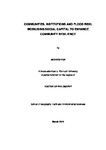Communities, Institutions and Flood Risk: Mobilising Social Capital to Enhance Community Resilience
| dc.contributor.supervisor | Wilson, Geoff | |
| dc.contributor.author | Fox, Andrew | |
| dc.contributor.other | School of Geography, Earth and Environmental Sciences | en_US |
| dc.date.accessioned | 2015-01-28T15:20:55Z | |
| dc.date.available | 2015-01-28T15:20:55Z | |
| dc.date.issued | 2014 | |
| dc.identifier | 10189781 | en_US |
| dc.identifier.uri | http://hdl.handle.net/10026.1/3214 | |
| dc.description.abstract |
Over recent years, community resilience has been increasing in popularity as a topic for detailed study. During that time, academic researchers have been working to untangle the complex network of social relationships that define the concept. In parallel, some institutions have set the achievement of enhanced community resilience as a policy goal. This research has sought to assist in both areas: first, by contributing to the academic debate and second, to build a clearer understanding of how institutions can tailor policies to ensure success in their goal of enhancing community resilience. A case study approach was adopted for the research, centring on three communities in the Teign Estuary of South Devon (Newton Abbot, Teignmouth and Shaldon). All three communities were vulnerable to tidal flooding and links between the communities and institutions responsible for managing flood risk (FRM framework) were analysed. In the analysis, a specific form of social capital was studied: social capital derived from community-institution links (CISC). CISC was found to be effective in revealing links with the greatest potential to enhance the resilience of communities against flood risks. To assess resilience at the individual and community level, a maturity based model was used. The assessment found disparities between how resilience matures at the community level compared to the individual level. Specifically, resilience maturity in communities was revealed as a less linear process. As such, the case study communities were able to exhibit traits associated with low resilience maturity at the same time as exhibiting traits associated with high resilience maturity. This research concluded that the UK FRM policy framework was robust, aligning well with academic theory. However, the FRM system was revealed as being dominated by expert elites. These elites are mainly public sector based and were judged to be stifling the engagement of the private sector at the local level. To enhance their resilience, this study determined that communities need to investment in CISC, but that investment must not just be targeted at public sector FRM institutions alone, it also needs to target private sector FRM institutions. | en_US |
| dc.language.iso | en | en_US |
| dc.publisher | Plymouth University | en_US |
| dc.subject | Community | en_US |
| dc.subject | Resilience | en_US |
| dc.subject | Social capital | en_US |
| dc.subject | Flood risk management | en_US |
| dc.title | Communities, Institutions and Flood Risk: Mobilising Social Capital to Enhance Community Resilience | en_US |
| dc.type | Thesis | |
| plymouth.version | Full version | en_US |
| dc.identifier.doi | http://dx.doi.org/10.24382/3443 |
Files in this item
This item appears in the following Collection(s)
-
01 Research Theses Main Collection
Research Theses Main


